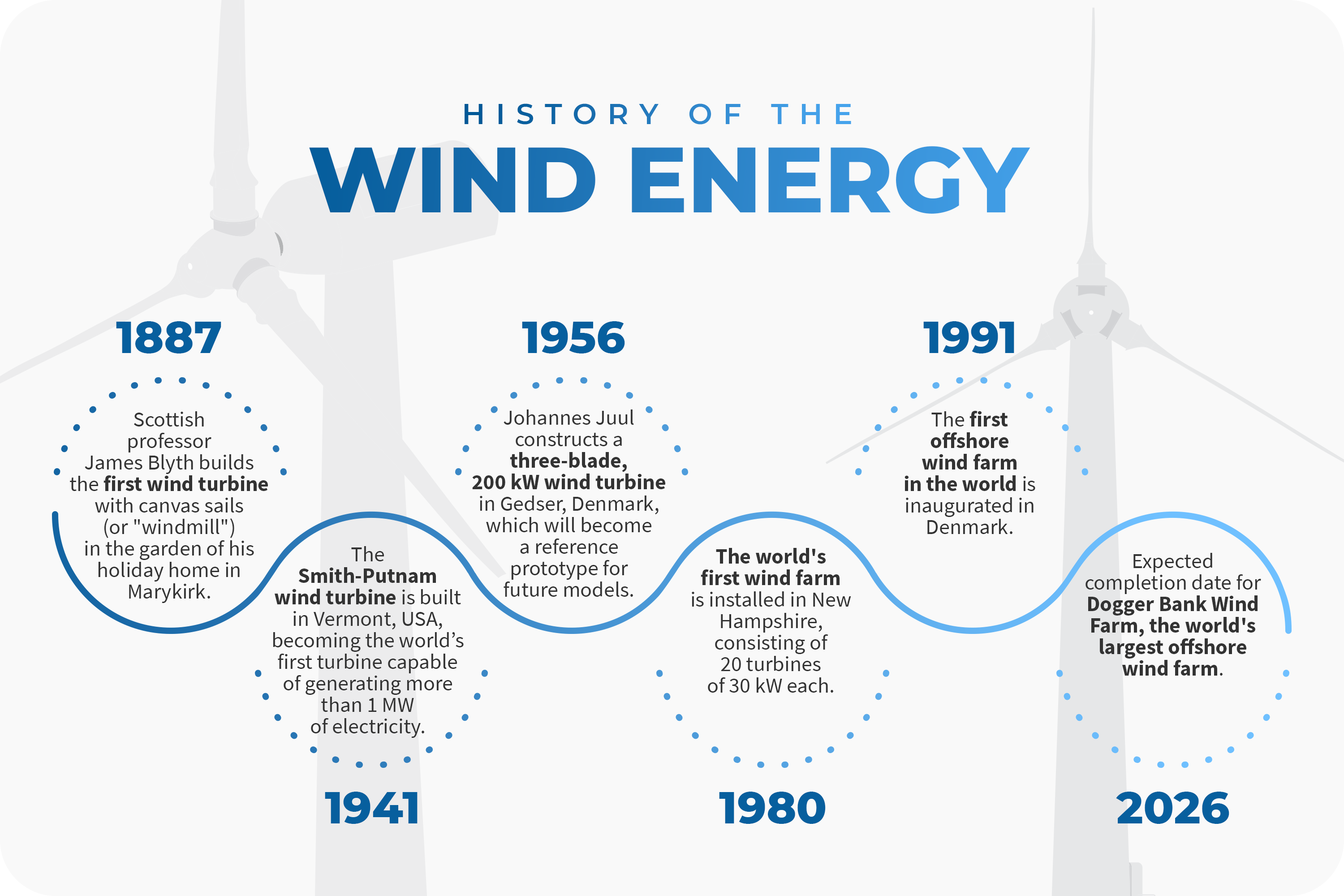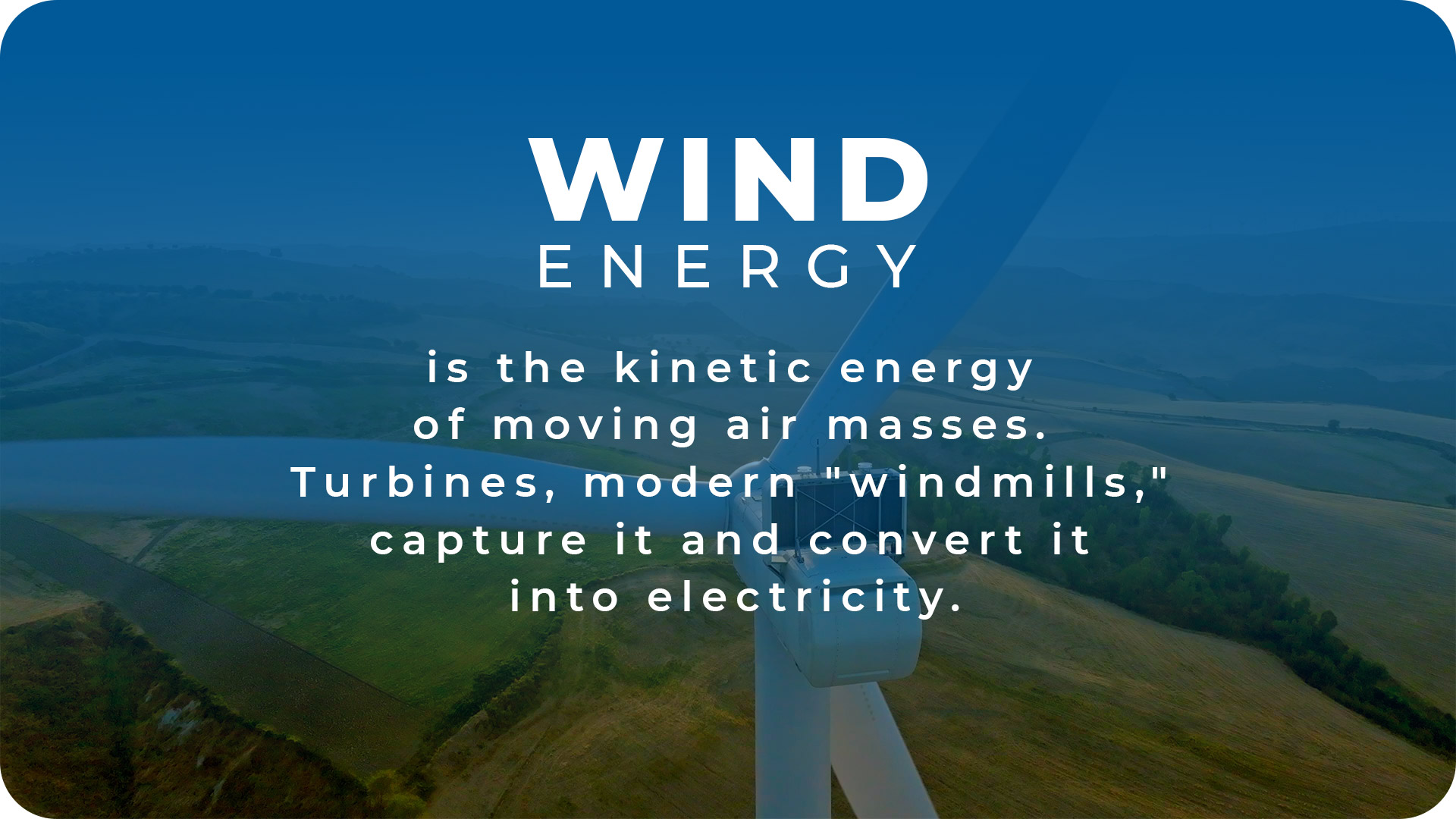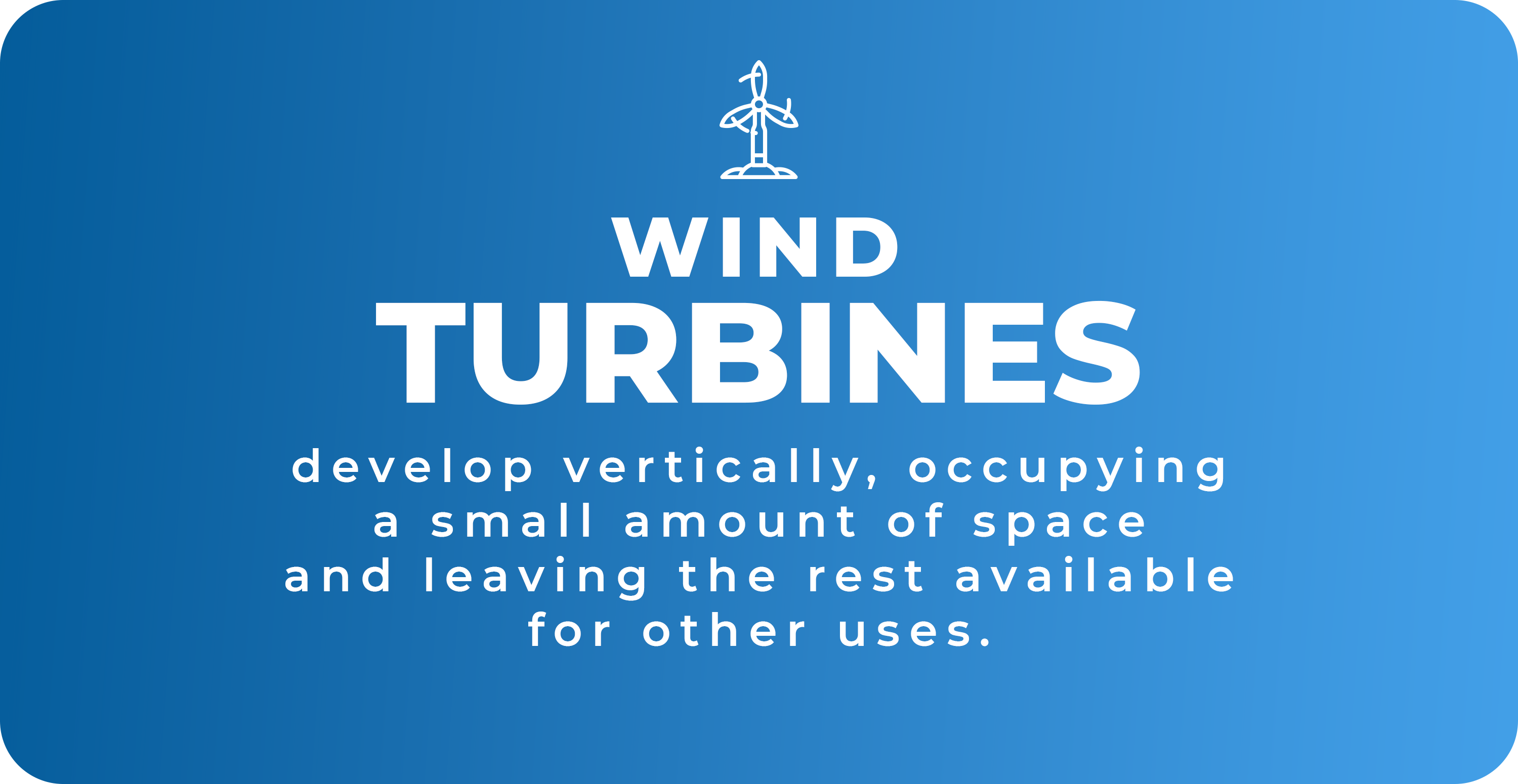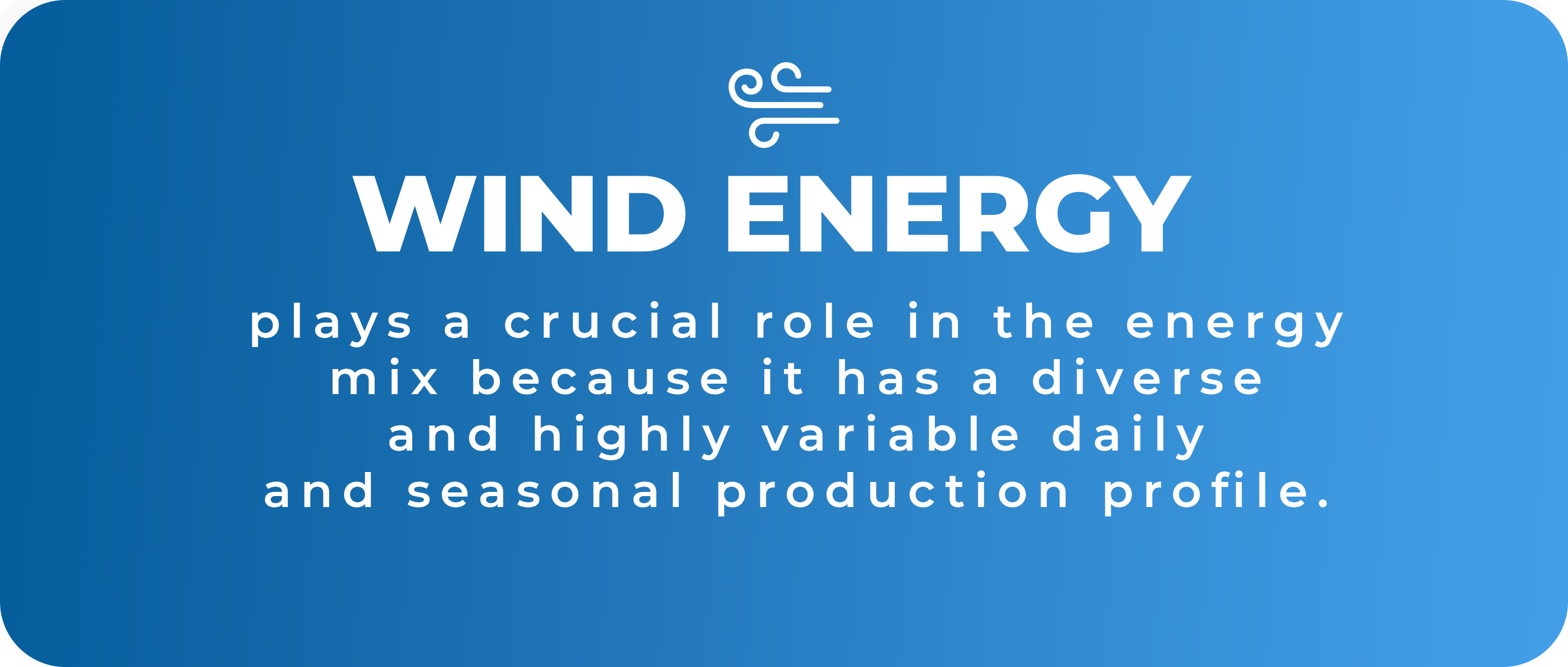Blades
typically three, designed to capture the maximum amount of wind energy. They can reach impressive lengths, up to 80 meters or more, and are made of lightweight yet durable materials like fiberglass.

Electricity generated by onshore and offshore wind farms is part of the renewable mix that supports the ongoing energy transition. History, curiosities, and technology of energy born from the wind.
"Having good wind" is a wish for good fortune, drawn from the common imagination of navigation. The very image of fully unfurled sails is a sign of success and progress. A primordial and unstoppable force, the wind has always fascinated and intimidated humanity. Since ancient times, we have sought to harness its energy, first to move ships and grind grain, then to generate electricity. Today, wind energy is one of the most promising renewable sources, and its contribution is considered strategic in the ongoing energy transition.
The idea of exploiting wind power dates back millennia. The first windmills appeared in Persia as early as the 7th century AD, while in Europe they became widespread during the Middle Ages. However, only in the 19th century, with the advent of electricity, did the idea develop of transforming the wind’s kinetic energy into electrical energy.

Our history of wind energy begins here, with the pioneering attempts to combine an ancient technology like windmills with electricity.

To explain wind energy, we start from when the wind meets the blades of a wind turbine, which are aerodynamically shaped like an airplane wing. As wind flows over the blades, it creates a pressure difference between the upper and lower surfaces, generating a lift force that causes the blades to rotate around the main shaft. This rotary motion is transmitted inside the nacelle, where a gearbox accelerates the shaft’s motion up to 1,500-1,800 revolutions per minute. The main shaft, which operates at low rotational speeds, is connected to a gearbox that transfers kinetic force to an electrical generator. This generator, using the principle of electromagnetic induction, converts mechanical rotational energy into electrical energy in the form of alternating current (AC) at the grid frequency. After being stepped up in voltage by a transformer, the electricity is fed into a substation, which further increases the voltage to match the public grid requirements, allowing it to be distributed into the network.
typically three, designed to capture the maximum amount of wind energy. They can reach impressive lengths, up to 80 meters or more, and are made of lightweight yet durable materials like fiberglass.
the assembly of blades and the main shaft. Its operation is based on aerodynamic lift: the blades have an asymmetrical shape, with a curved upper surface and a flat lower one. When wind flows over the blades, it creates a pressure difference that generates lift, making the rotor spin.
located at the top of the tower, it houses the main components of the turbine:
made of steel or reinforced concrete, it supports the nacelle and blades at an optimal height to capture the wind. Its height typically ranges from 80 to 140 meters, depending on the turbine’s power and the site’s characteristics.

Wind turbines, although installed at significant distances from each other, are often grouped to form what are known as wind farms. These can be located on land (onshore) or in open sea (offshore).
Onshore: wind farms are built on land, often in rural or hilly areas where wind blows more intensely. The proximity to the grid reduces energy loss during transmission, while construction and maintenance, which are generally straightforward, support local economic development.
Offshore: these wind turbines are installed in open sea, often at considerable distances from the coast. They take advantage of stronger and more constant winds, leading to higher and more predictable energy production compared to onshore farms. Depending on the water depth and seabed conditions, they can be installed on fixed foundations (monopile, gravity base) or floating structures. Offshore wind farms are more complex and costly to install and maintain, but their superior capacity offers immense potential for wind energy growth.

Like other renewable energy sources, wind energy offers significant benefits, contributing to the energy transition and positively impacting the economy and employment. Here are the main advantages.
Abundance and unlimited supply: wind energy is derived from an infinite, inexhaustible, and widely available source worldwide. It can be harnessed even in areas that would otherwise be unproductive or considered uninhabitable.
Vertical development: since turbines extend in height, surrounding land remains available for other productive activities such as agriculture.
Job creation: the wind sector, like other renewable energy sources, generates employment in various phases, from manufacturing and installation to management and maintenance.
High efficiency rate: according to Betz’s law, 59.3% of the wind’s kinetic energy can theoretically be converted into electricity. Though this is a theoretical maximum, it remains an impressive efficiency level.

Despite its advantages, wind energy has faced obstacles that have slowed its development. Addressing these challenges has driven progress in the wind sector in multiple ways.
Intermittency: Wind energy production depends on wind availability, which can vary in intensity and direction. The issue of intermittency can be mitigated through energy storage and integration with other sources like solar power.
Landscape impact: Onshore wind turbines can have a visual impact. To reduce this, they are installed in industrialized areas or regions with low landscape value. Innovative solutions are also being explored to better integrate them into the environment.
Impact on wildlife: Site selection is preceded by extensive studies on bird migration and local wildlife to choose the most suitable areas. Monitoring systems and deterrents are implemented, and turbine blades are designed to minimize risks to birds and bats.
According to data from the Global Wind Energy Council (GWEC), 2023 was the best year for wind power worldwide, surpassing 1 TW of total cumulative capacity for the first time. This result was achieved thanks to the 117 GW of newly installed capacity in 2023, marking a 50% year-over-year increase. However, these numbers are still not in line with the targets set by Agenda 2030. According to the Global Wind Energy Council, an additional 2 TW of capacity must be installed by 2030 to meet these objectives. Plenitude is actively contributing to this collective effort with installations in the USA, Kazakhstan, the United Kingdom, France, and Spain. The last two years, in particular, have seen the launch of large-scale projects, notably Green Volt in the North Sea, set to become a benchmark for floating foundation wind farms, and Dogger Bank Wind Farm in the United Kingdom, which, once completed, will become the world’s largest offshore wind farm with a capacity of 3.6 GW.

Several wind energy projects are currently under development in Italy, covering both onshore and offshore wind, particularly in the southern part of the country, where climate and geographical conditions make this renewable energy technology especially suitable. One example is the municipality of Borgia (Cz) in Calabria, where a 39 MW wind farm became operational in July 2024. Consisting of nine next-generation wind turbines, the plant is estimated to produce 84 GWh of electricity annually, equivalent to the yearly energy needs of over 30,000 households*. Discover the locations of our plants at this link.
* Calculation based on the estimated average annual electricity consumption in Italy of 2,700 kWh/year, according to data published by ARERA in the 2023 Annual Report.
There’s much more to discover!
In the North Sea, Vårgrønn, the Norwegian joint venture between Plenitude and HiTecVision, together with partner Flotation Energy, will build GreenVolt, the world's largest floating wind farm, with a capacity of up to 560 MW.
The continuously evolving scenario of energy, with its various complexities, requires technologies, investment, perseverance and commitment. This means that there is a great opportunity to accelerate the transition through the deployment of solar and wind
How tall is a wind turbine? How many parts make up a rotor? Find out more about wind farms in 4 pictures.